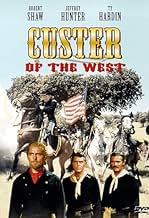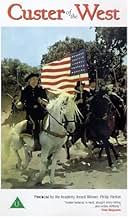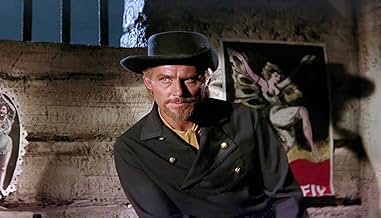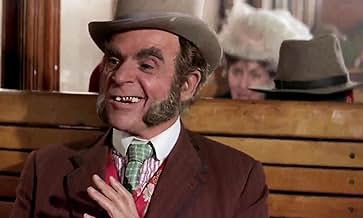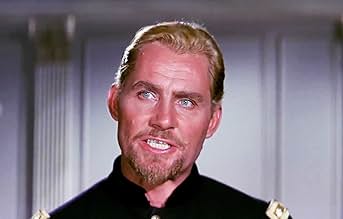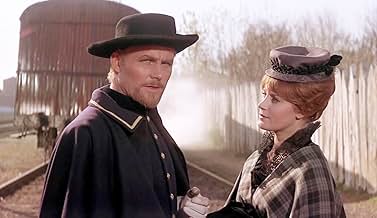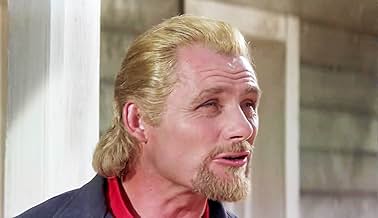IMDb RATING
5.8/10
1.7K
YOUR RATING
George Armstrong Custer's love of the heroic traditions of the Calvary and his distaste with the coming of industrialization leads him to his destiny at the Little Big Horn.George Armstrong Custer's love of the heroic traditions of the Calvary and his distaste with the coming of industrialization leads him to his destiny at the Little Big Horn.George Armstrong Custer's love of the heroic traditions of the Calvary and his distaste with the coming of industrialization leads him to his destiny at the Little Big Horn.
- Director
- Writers
- All cast & crew
- Production, box office & more at IMDbPro
Featured reviews
The film begins at the end of the Civil War and ends with the death of Custer and his troops at the Battle of Little Big Horn. It was filmed in single-camera Cinerama and had an impressively large cast.
I think your enjoyment of "Custer of the West" depends a lot on what your opinions are of the man, if any. As a former US History teacher, I look on the man as a very failed (if not a bit stupid) leader...so since I am not a fan, it made enjoying the film more difficult. More difficult still is that the movie didn't do a lot to humanize the man or tell you who he was apart from some general/lieutenant colonel.
Overall, reasonably good but not exactly a crowd-pleaser.
I think your enjoyment of "Custer of the West" depends a lot on what your opinions are of the man, if any. As a former US History teacher, I look on the man as a very failed (if not a bit stupid) leader...so since I am not a fan, it made enjoying the film more difficult. More difficult still is that the movie didn't do a lot to humanize the man or tell you who he was apart from some general/lieutenant colonel.
Overall, reasonably good but not exactly a crowd-pleaser.
I'll make this short and sweet, on second thought, I'll try to! For anyone who has studied history and even scanned a chapter about Custer, could tell that this story line seemed to be made-up as it went along. I have watched this movie only once, and that was more than enough. I understand Hollywoods need to add to, or change charactors or situations to sell a movie. BUT, when they feel the need to give Gen. Armstrong Custer an english accent, Wow!!! Flags went up as soon as he spoke. Ok, ok, overlook that. The thing that gets me the most is the way this movie seems to change the man, to what (I Guess) they wish he was. That too can be overlooked. But, when you change history around to such extremes as, lets pick on the Battle of the Little Big Horn. The way it is acted out is not only corny, but totally oblivious to the truth. The movie has Custer confronting the Indians right before the battle, (According to both versions{The Indians & The Whites} of history, HE DIDN'T).In the movie he didn't flee up the hill(as he did inreal life), away from the village, then finally dismount at almost the top of a hill, surrounded, there to die, and where some mutilations took place.Custer, being the last man standing(YEA, RIGHT!), gets an offer from the chief to let him go, (There was no, I repeat NO SUCH OFFER!) as there was in the movie. Enough you say, there had to be some good. Robert Ryan, in his, much to small a part, was, as usual top notch. However, the story being sooo far fetched ruined it for me. MY RATING: For the valid attept to make a movie,I give 1 Star, Add 1 Star for some decent Charactor Actors, & add 2 for Robert Ryans far too few moments. But, I have to subtract 1 just becaus they thought we wouldn't notice the english accent. 3 Out of 10 STARS
Handsome but dull western (courtesy of Spanish landscapes) to depict Custer on a mission to steal land from the Indians. A blond ROBERT SHAW looks convincing enough on horseback but something about his accent seems wrong and charisma is lacking. The Indians look more European than like American Indians and too many of the action scenes are slow paced and repetitive as Custer and his men go on various missions.
MARY URE as his wife, Libby, has little to do but register impatience with being kept in the background between battles with long waits before she shares the screen with real-life hubby, ROBERT SHAW. A more mature looking JEFFREY HUNTER (sporting gray hairs) is Will Benteen, one of Custer's more loyal officers.
The mountainous plains in Spain are no substitute for our standard glimpses of John Ford territory with not a single shot looking as though photographed in the American West. But it's the dull storyline that defeats the movie from ever becoming anything more than a series of handsomely photographed outdoor sequences. A surprise Indian attack by the Cheyennes on an Indepdence Day Celebration is one of the more colorful moments and triggers Custer's determination to fight the redskins, no matter that they greatly outnumber his men.
Nothing in Shaw's performance suggests the color and vigor of Custer's bigger than life personality nor does the screenplay do any real justice to the man or the myth. As storytelling goes, the first half of the film manages to be just plain dull and the film only picks up speed as it nears the climactic fight at Little Big Horn.
Battle skirmishes with Indians are, on the whole, well staged and full of furious gunsmoke and flying arrows--but the big set piece is saved, of course, for the finale which comes too late to save the first half of the film from the doldrums. One is left with the impression that some inventive fictionalizing would have helped (as it did with THEY DIED WITH THEIR BOOTS ON).
Summing up: A very miscast Shaw plays Custer as a snarling villain who barks orders and the story has a plodding script. Could have been much more impressive if filmed in the U.S. on more realistic locales with more accurate casting. A cameo by ROBERT RYAN is no help at all.
MARY URE as his wife, Libby, has little to do but register impatience with being kept in the background between battles with long waits before she shares the screen with real-life hubby, ROBERT SHAW. A more mature looking JEFFREY HUNTER (sporting gray hairs) is Will Benteen, one of Custer's more loyal officers.
The mountainous plains in Spain are no substitute for our standard glimpses of John Ford territory with not a single shot looking as though photographed in the American West. But it's the dull storyline that defeats the movie from ever becoming anything more than a series of handsomely photographed outdoor sequences. A surprise Indian attack by the Cheyennes on an Indepdence Day Celebration is one of the more colorful moments and triggers Custer's determination to fight the redskins, no matter that they greatly outnumber his men.
Nothing in Shaw's performance suggests the color and vigor of Custer's bigger than life personality nor does the screenplay do any real justice to the man or the myth. As storytelling goes, the first half of the film manages to be just plain dull and the film only picks up speed as it nears the climactic fight at Little Big Horn.
Battle skirmishes with Indians are, on the whole, well staged and full of furious gunsmoke and flying arrows--but the big set piece is saved, of course, for the finale which comes too late to save the first half of the film from the doldrums. One is left with the impression that some inventive fictionalizing would have helped (as it did with THEY DIED WITH THEIR BOOTS ON).
Summing up: A very miscast Shaw plays Custer as a snarling villain who barks orders and the story has a plodding script. Could have been much more impressive if filmed in the U.S. on more realistic locales with more accurate casting. A cameo by ROBERT RYAN is no help at all.
This is actually a sad movie. I will not mention the end for fear of including a "spoiler", but also I cannot imagine that most American viewers would not already know how it ends.
Though I live overseas now I grew up in the United States in the 1960s (in fact, I still retain my U.S. citizenship). Some of the lines in this 1967 movie are, in fact, anachronisms (they were not in the language in the 1860s or 1870s when this movie was set). The phrase that one U.S. soldier was worth (in combat) 10 Indians was a takeoff on the phrase used at that time in the Vietnam War concerning the kill ratio. Also, the term that General Sheridan used, "Bleeding hearts" comes from the 1960s; not the 1860s. The director of this movie was obviously comparing the moral problems we felt with Vietnam with the same problems the U.S. felt during the Indian Wars a century before. I did not know, of course, any Indian War veterans, but I did know two good men who went to Vietnam and did not come back alive.
Also tearful is the real life love you detect between George and Libby Custer that is portrayed by the real life married couple of Robert Shaw and Mary Ure. Six children between them. She died about ten years later from an accidental overdose of alcohol mixed with sleeping pills. He was so heartbroken that he died a few years later literally of a broken heart.
It is still a magnificent film. The western scenes are indigenous to that part of the United States that it is actually a shock to find out they were filmed not in South Dakota, California, Nevada, Kansas,etc. but rather in Spain!!
Though I live overseas now I grew up in the United States in the 1960s (in fact, I still retain my U.S. citizenship). Some of the lines in this 1967 movie are, in fact, anachronisms (they were not in the language in the 1860s or 1870s when this movie was set). The phrase that one U.S. soldier was worth (in combat) 10 Indians was a takeoff on the phrase used at that time in the Vietnam War concerning the kill ratio. Also, the term that General Sheridan used, "Bleeding hearts" comes from the 1960s; not the 1860s. The director of this movie was obviously comparing the moral problems we felt with Vietnam with the same problems the U.S. felt during the Indian Wars a century before. I did not know, of course, any Indian War veterans, but I did know two good men who went to Vietnam and did not come back alive.
Also tearful is the real life love you detect between George and Libby Custer that is portrayed by the real life married couple of Robert Shaw and Mary Ure. Six children between them. She died about ten years later from an accidental overdose of alcohol mixed with sleeping pills. He was so heartbroken that he died a few years later literally of a broken heart.
It is still a magnificent film. The western scenes are indigenous to that part of the United States that it is actually a shock to find out they were filmed not in South Dakota, California, Nevada, Kansas,etc. but rather in Spain!!
I won't go on too long about this. It's an efficiently told, largely fictional story of Custer and his last stand, sweetened up for the Whites in the audience and for their children.
It's impossible to imagine an American Indian watching this without feeling nauseous. Kieron Moore as Dull Knife. And at the end Custer seems to be fighting the Cheyenne -- period -- whereas he fought Sioux almost entirely. There were only seven Cheyenne warriors present at the battle. Westerns seem to enjoy dealing with the Cheyenne whenever they need generic Indians. I think it may be the name of the tribe -- The Cheyenne. It's easy to pronounce, and it sounds good. (It means something like "people with red feet" in Cheyenne.) "Sioux," on the other hand, sounds like a girl's name. "Apache" and "Comanche" are euphonious generic names too, but it's hard to get them all the way up to Montana. So what are you left with -- "Paiute"?
I didn't mind Robert Shaw's accent. He's a decent playwright but, regardless of which accent he's using, he can project nothing more than grim determination. When he seems to be enjoying himself, maybe smiling, you can't help feeling that it's calculated, that he's grimly determined to smile. As written, his role doesn't tell us much about Custer. Sometimes he seems brutal and other times, without too much tiresome exposition, he sounds like a liberal. Mary Ure is really appealing, a decent actress, without being staggeringly beautiful, who died an untimely death. Ty Hardin wasn't much of an actor, and he seemed to go politically bonkers after his brief career as a handsome hunky type. Jeffrey Hunter has a small part as the voice of humanitarianism. Lawrence Tierney has a beaut of a New York accent, but it may not be too out of place. Phil Sheridan was from New Jersey, wasn't he? (I may be wrong, but I don't want to bother looking it up.) Robert Ryan is the best actor in the bunch and his part is completely unnecessary, adding nothing to the picture.
The last stand is epic in a way it probably wasn't in real life, if that matters at all. The dead cavalrymen all wind up in something like a circular pile instead of being scattered along the slope up which they retreated. The Indians leave the remains alone, too, instead of violating them as they actually did. (Custer's body was stripped but unmutilated.) Indians tend not to like this kind of movie. On the anniversary of the battle in 1988 they installed a small plaque of crude, angry cast iron commemorating the many Indians who died in the battle. Right in the shadow of the phallic needle that remembers the 7th Cavalry. As it happens, I was living with the Cheyenne as an anthropologist at the time. I have never met a more admirable people. You don't hear much about Indian resentment of White's assumed superiority because they don't shout loud enough. Jane Fonda on her return from France in 1970 found them boring and too fond of alcohol so she went on to more exciting things.
It's impossible to imagine an American Indian watching this without feeling nauseous. Kieron Moore as Dull Knife. And at the end Custer seems to be fighting the Cheyenne -- period -- whereas he fought Sioux almost entirely. There were only seven Cheyenne warriors present at the battle. Westerns seem to enjoy dealing with the Cheyenne whenever they need generic Indians. I think it may be the name of the tribe -- The Cheyenne. It's easy to pronounce, and it sounds good. (It means something like "people with red feet" in Cheyenne.) "Sioux," on the other hand, sounds like a girl's name. "Apache" and "Comanche" are euphonious generic names too, but it's hard to get them all the way up to Montana. So what are you left with -- "Paiute"?
I didn't mind Robert Shaw's accent. He's a decent playwright but, regardless of which accent he's using, he can project nothing more than grim determination. When he seems to be enjoying himself, maybe smiling, you can't help feeling that it's calculated, that he's grimly determined to smile. As written, his role doesn't tell us much about Custer. Sometimes he seems brutal and other times, without too much tiresome exposition, he sounds like a liberal. Mary Ure is really appealing, a decent actress, without being staggeringly beautiful, who died an untimely death. Ty Hardin wasn't much of an actor, and he seemed to go politically bonkers after his brief career as a handsome hunky type. Jeffrey Hunter has a small part as the voice of humanitarianism. Lawrence Tierney has a beaut of a New York accent, but it may not be too out of place. Phil Sheridan was from New Jersey, wasn't he? (I may be wrong, but I don't want to bother looking it up.) Robert Ryan is the best actor in the bunch and his part is completely unnecessary, adding nothing to the picture.
The last stand is epic in a way it probably wasn't in real life, if that matters at all. The dead cavalrymen all wind up in something like a circular pile instead of being scattered along the slope up which they retreated. The Indians leave the remains alone, too, instead of violating them as they actually did. (Custer's body was stripped but unmutilated.) Indians tend not to like this kind of movie. On the anniversary of the battle in 1988 they installed a small plaque of crude, angry cast iron commemorating the many Indians who died in the battle. Right in the shadow of the phallic needle that remembers the 7th Cavalry. As it happens, I was living with the Cheyenne as an anthropologist at the time. I have never met a more admirable people. You don't hear much about Indian resentment of White's assumed superiority because they don't shout loud enough. Jane Fonda on her return from France in 1970 found them boring and too fond of alcohol so she went on to more exciting things.
Did you know
- TriviaSome sources have suggested that this was originally to be directed by Akira Kurosawa, but he pulled out. However, this is massively unlikely, given the production history of the film. The more likely explanation is that Kurosawa was approached about directing a different film project on the same subject, "The Day Custer Fell", which was in the works at 20th Century Fox for several years, and for which several Japanese actors famous for working with Kurosawa were approached to play the leading Native American roles. Fred Zinnemann was eventually attached to this project, but it was canceled by Fox because of its ever-escalating budget. "Custer Of The West" was put together very quickly (and made rather cheaply) once this occurred.
- GoofsThe troops of the 7th Cavalry are shown with 1873 Winchester rifles, which were in wide use by 1876, but not by the US Army. Custer's men were armed, as all troopers who did not purchase their own rifles were, with the 1873 Springfield Trapdoor carbine, a single-shot weapon. Had Custer's men been armed with the Winchester, it is possible, though unlikely, that they could have held out until relieved.
- Quotes
Gen. Philip Sheridan: You know, you could become a living legend... or get yourself killed. Dead men make better legends.
- Alternate versions35mm prints released in both complete and shortened versions. Some shortened versions were titled "A Good Day for Fighting".
- ConnectionsFeatured in I Am Not Your Negro (2016)
- How long is Custer of the West?Powered by Alexa
Details
Box office
- Budget
- $4,000,000 (estimated)
- Runtime2 hours 20 minutes
Contribute to this page
Suggest an edit or add missing content

